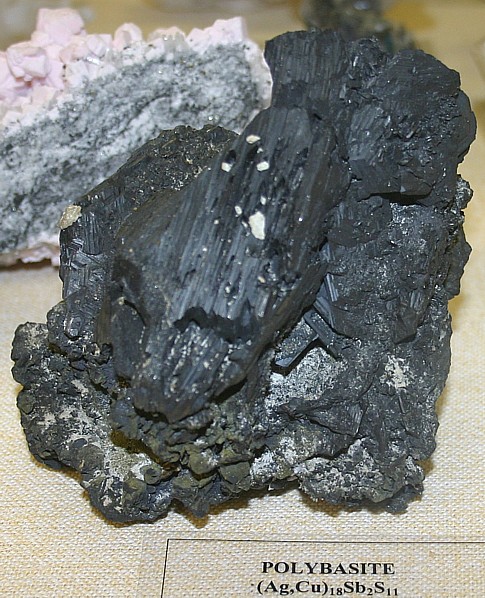|
.
Polybasite Mineral Facts:
Chemical
Formula: (Ag,Cu)3SbS6
Colors:
Dark Gray to black.
The mineral is nearly opaque. Except in very thin splinters it is
steel-gray to iron-black in color. Very thin plates are translucent and
cherry-red.
Hardness:
2 to 3
Hardness varies somewhat depending
on formation and impurities.
Density: 6
to 6.2
Cleavage:
The cleavage
is perfect parallel to (001) and the fracture uneven.
Crystallography: Monoclinic
Crystals are
pseudorhombohedral in symmetry, occurring in short hexagonal prisms,
often thin and tabular. Basal planes show triangular markings.
Luster:.
Sub-metallic to metallic
Optics:
(Refractive Index) Opaque
|
 |
Composition,
Structure and Associated Minerals:
Polybasite is a comparatively rare silver mineral, associated with other
sulphantimonides of silver and with silver ores in general. Typical
associated minerals include Acanthite, tetrahedrite, and other more common
sulfides. It is formed at low to moderate temperatures.
Identification and Diagnostics
The mineral is easily fusible. On
charcoal gives dense white coating of antimony trioxide with odor of
sulphur dioxide. After decomposition by nitric acid, the filtrate with
hydrochloric acid gives white precipitate of silver chloride. It
exhibits the reactions for Ag, Sb, and S. It is readily distinguished
from all other minerals but silver sulpho-salts by their blowpipe
reactions. From these
Polybasite is
distinguished by its crystallization. Pearceite and polybasite are
distinguished from one another by the relative quantities of As and Sb
they contain.
Occurrence,
Localities and Origins:
Polybasite occurs
both as a primary mineral, and in the zone of secondary enrichment in veins
rich that are rich with silver sulphides. Polybasite was an important ore of
silver in the Comstock Lode, Nevada. It has also been mined with other
silver ores at Ouray, Colorado, at Marysville, Montana, at Guanajuato,
Mexico, and at various points in Chile. Good crystals occur at Freiberg,
Saxony, at Joachimsthal, Bohemia, and in the mines in Colorado, Mexico and
Chile. The name
is an allusion to the many bases contained in the
mineral. It is a valuable ore of silver. The mineral often runs around 60%
silver by weight, though the percentages vary quite a bit.
Return to the
Mineral Collectors Information Page |
|


